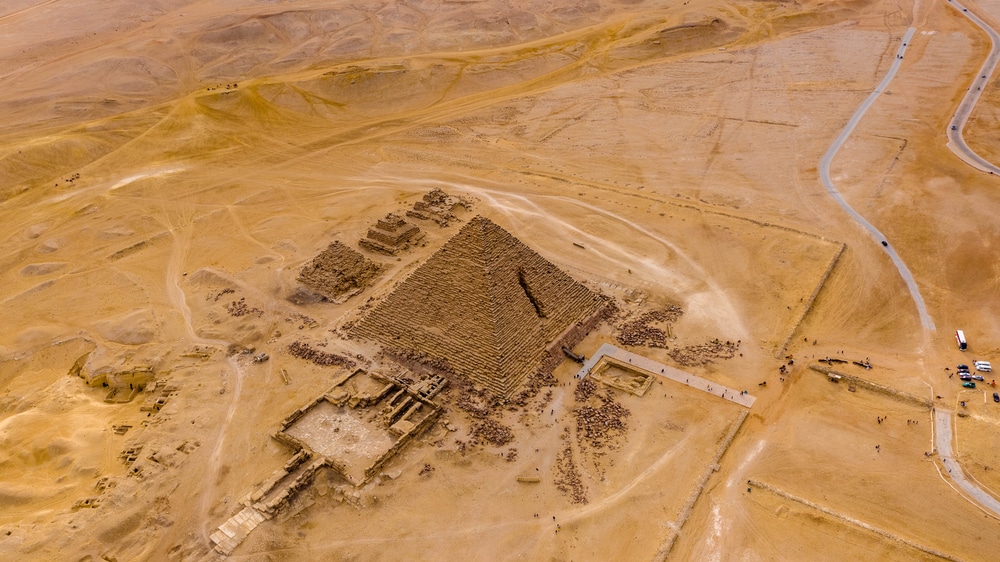Recent developments in archaeological research have reignited fascination with Egypt’s Giza Pyramids, as experts express growing confidence in the possibility of a sprawling underground city hidden beneath the iconic structures.
A combination of new radar discoveries and ongoing scientific debate has thrust this theory into the spotlight, though skepticism persists among some prominent figures in the field.
According to a report from The Daily Mail, Italian scientists using synthetic aperture radar (SAR) have identified what they describe as a series of subterranean shafts and chambers beneath the Giza Plateau.
The findings, detailed in a press release, include eight tubular wells descending into two large cubic chambers located approximately 648 meters below the Second Pyramid.
Researchers suggest these megastructures could be part of a larger network, potentially supporting claims of a “vast city” lost to time. The outlet notes that while the discovery has sparked excitement, some experts remain cautious, urging further investigation before drawing definitive conclusions.
Adding to the buzz, Newsweek reported that these radar scans have bolstered earlier hypotheses about hidden structures beneath Giza.
The publication highlighted how the new data aligns with previous speculations of underground complexes, though it emphasized that no peer-reviewed scientific paper has yet been published to substantiate the claims.
This lack of formal documentation has fueled both intrigue and uncertainty, with some calling the findings “too extraordinary to believe without hard evidence.”
The story has also caught the attention of BBC News, which interviewed Dr. Zahi Hawass, a renowned Egyptian archaeologist and former Minister of Antiquities.
Hawass dismissed the notion of a vast underground city as “unscientific,” arguing that the radar anomalies could be natural geological formations rather than man-made structures.
He stressed the need for rigorous excavation and peer-reviewed studies, cautioning against what he sees as premature sensationalism.
Despite his skepticism, the BBC noted that the radar evidence has prompted renewed calls for exploration, with some researchers advocating for advanced imaging techniques to settle the debate.
Meanwhile, The Guardian explored the historical context of the claims, pointing out that tales of hidden chambers beneath the pyramids have circulated for centuries.
The article cited the recent findings as a potential breakthrough, but echoed concerns about the absence of concrete proof.
It quoted an Italian researcher involved in the study who argued that the scale and precision of the detected structures suggest intentional design, hinting at a sophisticated underground system possibly used for storage, rituals, or habitation.
Across the Atlantic, The New York Times took a broader view, framing the discovery within the ongoing quest to unlock the mysteries of the pyramids.
The piece acknowledged the technological promise of SAR, which can penetrate deep into the earth to reveal hidden features, but also highlighted the divide among experts.
While some see the data as a tantalizing clue, others, including geophysicists consulted by the Times, propose that the anomalies might reflect natural cavities or water channels rather than an ancient metropolis.
Social media posts on X have amplified the story, with users sharing links to articles and speculating about the implications.
Some express awe at the idea of a lost city, while others echo the skepticism of experts like Hawass, labeling the claims as exaggerated. The lack of an official scientific paper, as noted in several posts, remains a sticking point for those awaiting confirmation.
As the debate unfolds, the international press continues to monitor the situation.
Al Jazeera reported that Egyptian authorities have yet to announce plans for further exploration, though the findings have sparked interest among tourists and historians alike.
Whether these underground structures prove to be a monumental discovery or a misinterpreted anomaly, the Giza Pyramids remain a source of endless wonder—and contention—in the world of archaeology.










